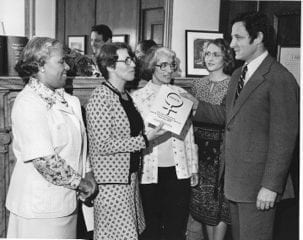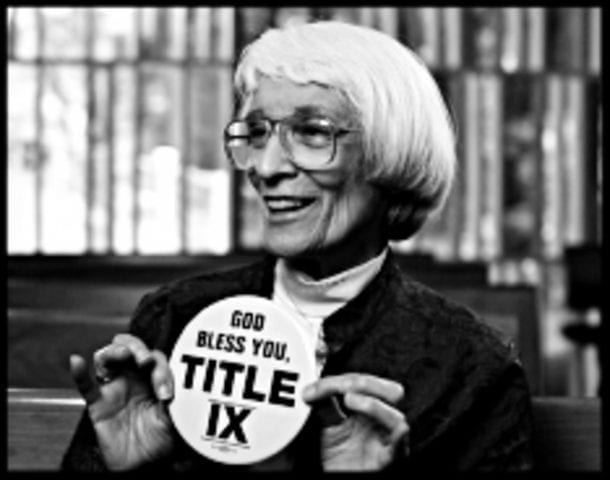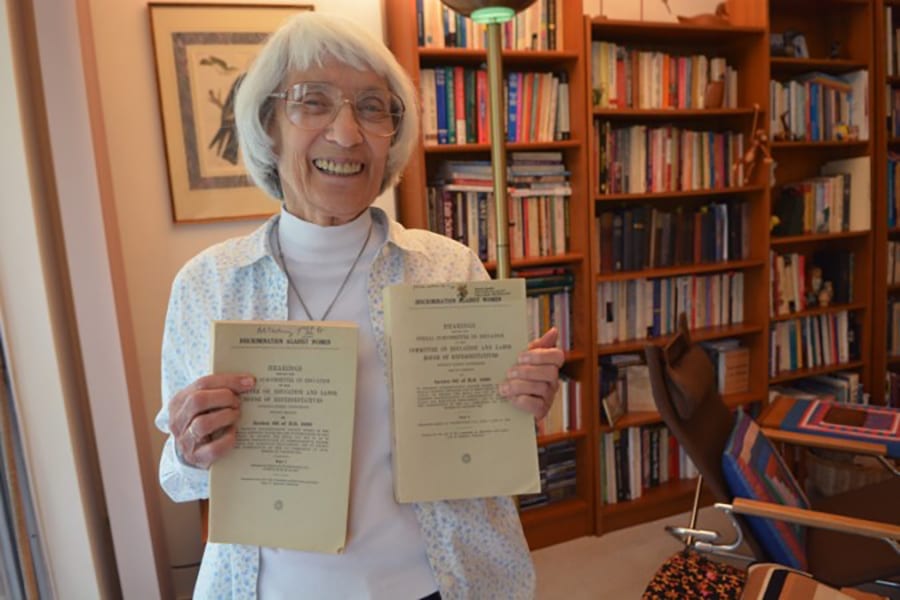Introducing the “Godmother of Title IX”
For American women coming of age after 1972, high school and college sports are a fact of life that we take for granted. Of course my school had both men’s and women’s ice hockey teams. Yeah, of course the women’s soccer team has their own locker room. But it wasn’t always that way. And those of us who learned about teamwork, discipline, tenacity and strategy on the rink or the field have a woman named Bernice Sandler to thank. Heck, most of us wouldn’t have been able to attend college in the first place if it wasn’t for Sandler. Yup, higher education was a lot different a few decades ago.
In 1969, Sandler—who had just completed her doctorate in education—was making her rounds at universities throughout the Northeast in search of work. She had the credentials and experience required of tenured professors, but found herself being passed over for the best jobs again and again. “You come on too strong for a woman,” one male interviewer told her. In lieu of a teaching job, Sandler took a position with the Women’s Equity Action League (WEAL) where she spearheaded efforts to end gender discrimination in education through legal action and lobbying.

Bernice Sandler with Birch Bayh, former Indiana senator and author of Title IX. He recently passed away on March 14, 2019 at the age of 91.
In 1967, President Lyndon Johnson had signed an executive order which prohibited discrimination on the basis of race, creed, color, national origin or gender at any government agency or contracted firm which receives government money. But it seems that the institutions Sandler had been interviewing at had not been notified of this change in status. Prior to Johnson’s order, it was perfectly legal for a medical school to only admit two women per year, regardless of how many applied. And no one balked at an institution that had virtually no female professors. Sandler and her team set to work filing class action lawsuits against universities all over the country and compiling data on gender disparity in higher education. Sandler’s stats became the firepower for a bill making its way through Congress which explicitly prohibited gender discrimination in higher education, from the admissions guidelines to the teaching staff to the athletics fields. The bill—known as Title IX of the Education Amendments—was signed into law by President Richard Nixon in 1972, and college life in America hasn’t been the same ever since.
![]() Sex prejudice is so ingrained in our society that many who practice it are simply unaware that they are hurting.
Sex prejudice is so ingrained in our society that many who practice it are simply unaware that they are hurting.
It is the last socially acceptable prejudice.
—Bernice Sandler
![]()
Sandler estimated that a few years of lobbying and legal work would get America’s institutes of higher learning into full compliance on gender equality. But that’s where she was wrong. Title IX moved mountains as far as increasing admissions for female students (who now outnumber men at many colleges in the country), and achieving gender parity for professors. But there are still plenty of elite, impermeable dens where women are not warmly welcomed, particularly within the tech sector. And it is also important to remember that in addition to her pioneering work involving gender discrimination, Sandler was also the first researcher to study the impact and incidence of gang rape on campus as well as peer discrimination in education and on the job. Look no further than the #MeToo Movement to assess how much work lies ahead regarding sexual harassment and gender discrimination in the workplace.
In January of 2019, Sandler passed away at the age of 90. Prior to her death, when reflecting on her legacy, she compared the impact of Title IX legislation to the cultural and social changes brought about by the Industrial Revolution. She noted that men and women “are far closer to equal than they have ever been in the history of the world,” but conceded that her work constituted “the very first steps of what will be a very long journey.”


